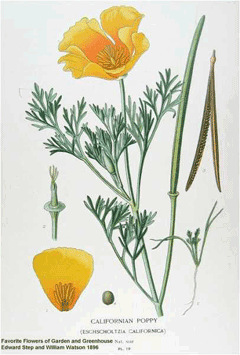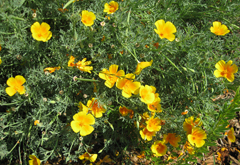 |
|
http://commons.wikimedia.org/wiki/File:Eschscholzia_californica_i01.jpg |
 |
| (c) Trina Krieger |
Translate this page:
Summary
Bloom Color: Orange, Pink, Red, Yellow. Main Bloom Time: Early summer, Early fall, Late summer, Late fall, Late spring, Mid summer, Mid fall, Mid spring. Form: Rounded.
Physical Characteristics

 Eschscholzia californica is a PERENNIAL growing to 0.3 m (1ft) by 0.2 m (0ft 8in) at a fast rate.
Eschscholzia californica is a PERENNIAL growing to 0.3 m (1ft) by 0.2 m (0ft 8in) at a fast rate.
See above for USDA hardiness. It is hardy to UK zone 6. It is in flower from July to September, and the seeds ripen from August to September. The species is hermaphrodite (has both male and female organs) and is pollinated by Bees.
It is noted for attracting wildlife.
Suitable for: light (sandy), medium (loamy) and heavy (clay) soils, prefers well-drained soil and can grow in nutritionally poor soil. Suitable pH: mildly acid, neutral and basic (mildly alkaline) soils. It cannot grow in the shade. It prefers dry or moist soil. The plant can tolerate maritime exposure.
UK Hardiness Map
US Hardiness Map
Synonyms
E. douglasii.
Plant Habitats
Cultivated Beds;
Edible Uses
Edible Parts: Leaves
Edible Uses:
Leaves - cooked[46, 61, 161]. This plant is in a family that contains many poisonous plants so some caution is advised in using it.
References More on Edible Uses
Medicinal Uses
Plants For A Future can not take any responsibility for any adverse effects from the use of plants. Always seek advice from a professional before using a plant medicinally.
Anodyne Antianxiety Antidepressant Antispasmodic Diaphoretic Diuretic Galactofuge Odontalgic
The Californian poppy is a bitter sedative herb that acts as a diuretic, relieves pain, relaxes spasms and promotes perspiration[238]. The whole plant is harvested when in flower and dried for use in tinctures and infusions[238]. It is taken internally in the treatment of nervous tension, anxiety, insomnia and incontinence (especially in children)[238]. The watery sap is mildly narcotic and has been used to relieve toothache[238]. It is similar in its effect to the opium poppy (Papaver somniferum) but is much milder in its action and does not depress the central nervous system[238]. Another report says that it has a markedly different effect upon the central nervous system, that it is not a narcotic but tends to normalize psychological function[254]. Its gently antispasmodic, sedative and analgesic actions make it a valuable herbal medicine for treating physical and psychological problems in children[254]. It may also prove beneficial in attempts to overcome bedwetting, difficulty in sleeping and nervous tension and anxiety[254]. An extract of the root is used as a wash on the breasts to suppress the flow of milk in lactating females[207, 257].
References More on Medicinal Uses
The Bookshop: Edible Plant Books
Our Latest books on Perennial Plants For Food Forests and Permaculture Gardens in paperback or digital formats.

Edible Tropical Plants
Food Forest Plants for Hotter Conditions: 250+ Plants For Tropical Food Forests & Permaculture Gardens.
More

Edible Temperate Plants
Plants for Your Food Forest: 500 Plants for Temperate Food Forests & Permaculture Gardens.
More

More Books
PFAF have eight books available in paperback and digital formats. Browse the shop for more information.
Shop Now
Other Uses
Perennial groundcover for zone 2 firebreaks. The US government has created a system of firebreaks for areas prone to wildfires, theses are separated into concentric zones surrounding buildings. Zone 2 is the second away from the house. These low-level groundcovers provide little fuel.
Special Uses
Attracts Wildlife
References More on Other Uses
Cultivation details
Landscape Uses:Border, Container, Foundation, Massing, Rock garden. Prefers a poor sandy soil and a sunny position[108, 200] but is easily grown in an ordinary garden soil[1]. Succeeds in a hot dry position. Plants grow well in maritime climates[200]. A very ornamental plant, it is commonly grown in the flower garden and there are many named varieties[200]. This plant is the state flower of California[207]. Although a perennial it is usually quite short-lived and is more often grown as an annual in this country[187, 238]. It can tolerate temperatures down to about -10°c, however, and often survives mild winters[187]. If the dead flowers are removed before they set seed the plant will continue flowering for a longer period[188]. A polymorphic species[71]. Plants resent root disturbance and should be sown in situ[200]. The flowers are very attractive to bees[108]. They close during wet or overcast weather[238]. Plants often self-sow if the soil is disturbed by some means such as hoeing[200]. Special Features: Attractive foliage, North American native, Naturalizing, Suitable for cut flowers, Extended bloom season in Zones 9A and above. Heat Zone: 9-2.
References Carbon Farming Information and Carbon Sequestration Information
Temperature Converter
Type a value in the Celsius field to convert the value to Fahrenheit:
Fahrenheit:
The PFAF Bookshop
Plants For A Future have a number of books available in paperback and digital form. Book titles include Edible Plants, Edible Perennials, Edible Trees,Edible Shrubs, Woodland Gardening, and Temperate Food Forest Plants. Our new book is Food Forest Plants For Hotter Conditions (Tropical and Sub-Tropical).
Shop Now
Plant Propagation
Seed - sow in mid spring or late summer to early autumn in a sunny border outdoors and only just cover the seed[200]. Autumn sown plants may require protection from frosts in cold winters[200]. The seed usually germinates in 2 - 3 weeks.
Other Names
If available other names are mentioned here
Native Range
NORTHERN AMERICA: United States (Oregon (west), Washington (southwest), New Mexico (southwest), Texas, Arizona, California, Nevada (s. & w.), Utah (southwest)), Mexico (Baja California (Norte) (northwest), Chihuahua (northwest), Sonora (north))
Weed Potential
Right plant wrong place. We are currently updating this section.
Please note that a plant may be invasive in one area but may not in your area so it's worth checking.
Conservation Status
IUCN Red List of Threatened Plants Status :

Growth: S = slow M = medium F = fast. Soil: L = light (sandy) M = medium H = heavy (clay). pH: A = acid N = neutral B = basic (alkaline). Shade: F = full shade S = semi-shade N = no shade. Moisture: D = dry M = Moist We = wet Wa = water.
Now available:
Food Forest Plants for Mediterranean Conditions
350+ Perennial Plants For Mediterranean and Drier Food Forests and Permaculture Gardens.
[Paperback and eBook]
This is the third in Plants For A Future's series of plant guides for food forests tailored to
specific climate zones. Following volumes on temperate and tropical ecosystems, this book focuses
on species suited to Mediterranean conditions—regions with hot, dry summers and cool, wet winters,
often facing the added challenge of climate change.
Read More
Expert comment
Author
Cham.
Botanical References
6071200
Links / References
For a list of references used on this page please go here
Readers comment